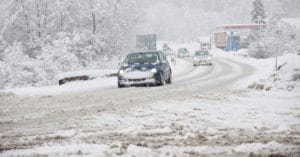Have you been injured while driving? We all try to be safe driving in snow, however sometimes accidents happen. Contact us for legal help.
Safe driving in snow is no accident. Statistically, accidents on snowy and icy roads claim the lives of twice as many people as all other severe weather hazards combined. Icy roads also contribute to millions in property damage

each year.
People mostly know to be cautious when driving during the big winter storms. The statistics show it’s more common to be involved in a crash during a light icing event. It makes some sense when you think about it. Schools and workplaces close during big storms. On the other hand, people often take a “business as usual” approach when there’s a light dusting of snow or a quick melt and freeze. This mistake can prove deadly.
Slowing Down Is the Number One Skill
The most important thing to remember during the winter months is that no one has the skill necessary to drive normal highway speeds on icy roads. SLOW DOWN. Speed limits are intended for ideal road conditions. Even if you’re an excellent driver who has never had so much as a parking ticket, you can’t maintain control of your vehicle without slowing down. Safety features like 4WD offer some protection during the winter months. But 4-wheel drive is not magic. It does not eliminate the danger of losing control while traveling at highway speeds on icy roads. Winter tires help your vehicle move on snow and ice covered roads. And while they can improve stopping distance to a degree, they do not increase traction in a way that makes your vehicle stop just like it was on a dry road.
For a straight level interstate, it’s suggested that traveling 35 mph to 40 mph is safest. When traveling above 45 mph, it becomes much harder to maintain control of your vehicle. If you encounter interchanges, merging traffic zones, and accident sites, you’ll need to travel even slower.
Basic Tips for Safe Driving In Snow
- Wear your seatbelt
- Go easy on your brakes
- Keep extra distance from other drivers.
- Turn into a slide.
- Don’t forget that bridges freeze before roads.
- Remember that steep hills, curves, and tunnels can be especially dangerous in icy weather.
Hepworth Holzer Can Help
Negligent drivers can be held financially liable for the damages they cause to others while driving on icy roads. If you or someone you love has been injured by a negligent driver, you may be entitled to compensation for your medical bills and other accident-related expenses. Call (208) 328-6998 or toll-free at (888) 343-7510 to speak with the experienced personal injury attorneys at Hepworth Holzer.


The above text “Safety features like 4WD offer some protection during the winter months. But 4-wheel drive is not magic. It does not eliminate the danger of losing control while traveling at highway speeds on icy roads. Winter tires help your vehicle move on snow and ice covered roads. But, they do nothing to make it easier for your vehicle to stop in time to avoid a crash.” is not entirely correct. It is true that all/4-wheel-drive does not help a vehicle stop in most cases – with the exception of lockable differentials which can help to avoid individual wheel lockup in the absence of more effective ABS. However winter/snow tires will in fact increase traction for not only starting and turning, but also stopping on snowy/icy surfaces. Example tire test: http://www.caranddriver.com/comparisons/2009-winter-tire-test-comparison-tests
Thanks for the input–revised